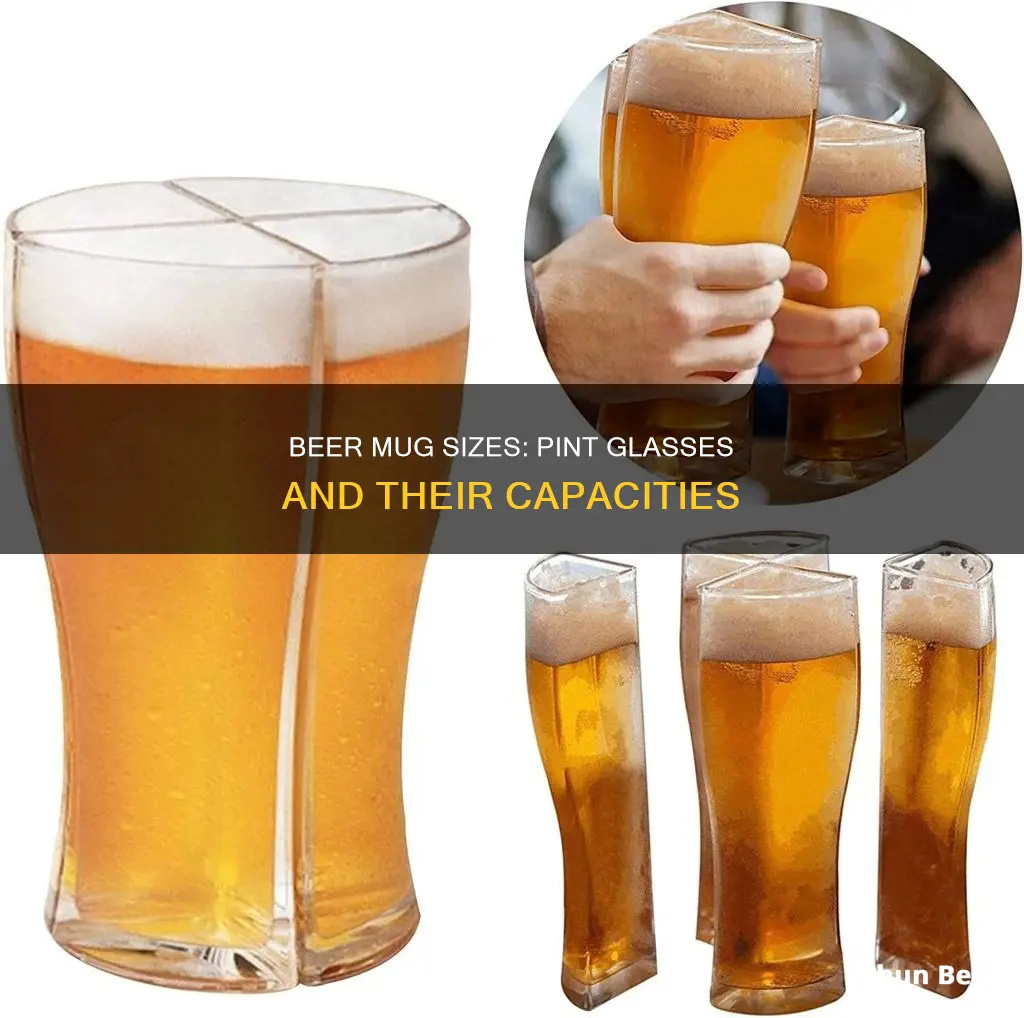
The size of a pint beer mug varies depending on the country and the type of pint. In the US, a pint glass typically holds 16 US fluid ounces (473 ml), while in the UK, an imperial pint is equivalent to 20 imperial fluid ounces (568 ml). Pint glasses can also differ in shape, with the most common types being conical, nonic, and jug glasses. The choice of glassware is important for beer drinkers as it can enhance the taste and overall drinking experience.
| Characteristics | Values |
|---|---|
| Country | UK |
| Volume | 568 ml |
| US Equivalent | 1.2 pints |
| US Fluid Ounces | 20 |
| US Pint Glass Volume | 473 ml |
| US Pint Glass US Fluid Ounces | 16 |
| Shape | Conical, Nonic, Jug Glasses ("Dimple Mugs"), Tulip Glasses |
| Height | 6 inches (15 cm) |
| Tapering | 1 inch (25 mm) in diameter |
What You'll Learn

The definition of a pint varies by country
The definition of a pint does indeed vary by country. In the United States, a pint is 16 US fluid ounces (473 ml). However, the volume is not strictly regulated, and glasses may vary in size. In the United Kingdom and Ireland, a pint refers to the British imperial pint, which is about 20% larger than the American pint at 20 imperial fluid ounces (568 ml).
In Canada, Federal law mandates the use of the standard imperial pint. However, this law is not always enforced, and some establishments may serve US pints or other measures instead. In Australia, a "pint" of beer will get you 425 ml in South Australia, but 570 ml in the rest of the country. In New Zealand, there is no legal requirement for beer to be served in standard measures, and the volume of a "pint" can vary.
In some countries, the term "pint" is used more as a generic name for beer, and the serving size may differ. For example, in Belgium, a "pint" can refer to 250 ml or 330 ml, while in Germany, it can range from 200 ml to 1,000 ml, depending on the type of beer and the region. In France, a "pint" typically refers to a half-litre (500 ml), but can also be used for 250 ml or 330 ml servings.
Stout Beer: Exploring the Diverse Classifications and Flavors
You may want to see also

The American pint glass holds 16 ounces
The American pint glass is the most common type of beer glass and is the top choice for most restaurants and bars due to its versatility and price. It can serve just about any beer and is the perfect size to get you to enjoy your drink without it getting warm and flat. It is also easy to clean and store, with tapered, straight sides.
The American pint glass is also known as a 'shaker pint' as it can be used as one half of a Boston shaker for cocktails. It is typically around 6 inches (15cm) tall and tapers by about 1 inch (25mm) in diameter.
The American pint glass is similar in size to the pilsner glass, which holds 14 ounces and is used for light beers such as pale lager or pilsner. However, the American pint glass is more versatile and can be used for IPAs, ales, stouts, and lagers.
Beer vs Vodka: Understanding Alcoholic Beverage Differences
You may want to see also

The Imperial pint glass holds 20 ounces
The Imperial pint glass is a versatile option for beer drinkers, capable of holding a substantial 20 ounces of their favourite brew. That's about 568 millilitres, or 1.2 US pints, for those who prefer their measurements imperial. In the United Kingdom, this is the standard serving size for beer, as dictated by law.
The Imperial pint glass is a tad larger than its American counterpart, which holds 16 ounces, or 473 millilitres. This makes the Imperial pint glass perfect for those who want to savour their beer without feeling rushed to finish it before it gets warm and flat.
The Imperial pint glass is designed with a small lip, which encourages drinkers to take a generous gulp of their beverage, rather than sipping it. This makes it ideal for ales, lagers, and stouts. Its straight sides taper outwards, giving it a sleek and elegant appearance.
The Imperial pint glass is a common sight in British and Irish pubs, where it is favoured for its combination of style and functionality. It is also known as a conical glass due to its shape, resembling an inverted truncated cone. Typically, these glasses stand around 6 inches tall and taper by about an inch in diameter.
So, if you're looking for a beer glass that offers a generous serving, the Imperial pint glass is a great choice. Its combination of capacity, design, and versatility makes it a popular option for beer enthusiasts.
EBC Beer Shipping: State-by-State Availability and Restrictions
You may want to see also

The pint glass comes in different shapes
Conical Glasses
Conical glasses, also known as "sleevers" or "shaker pints", are shaped like inverted truncated cones, tapering by about 1 inch in diameter over their 6-inch height. They are the most common type of pint glass in the United States and are often used in cocktails as part of a Boston shaker. The design allows for easy stacking and reduces breakage.
Nonic Glasses
Nonic glasses, pronounced "no-nick", are a variation of the conical design with a bulge near the top. This design improves grip, prevents stacking issues, and adds strength to the glass, reducing chipping. Hugo Pick of Albert Pick & Co. designed the Nonic glass, which became popular in the United Kingdom after World War II.
Jug Glasses or "Dimple Mugs"
Jug glasses, also known as "dimple mugs", resemble large mugs with handles. They feature a grid pattern of thickened glass on the outside, resembling a hand grenade. The dimples improve grip and washing, and the design emphasises strength. These glasses are now rarer and considered more traditional.
Tulip Glasses
Tulip glasses are modern interpretations of the pint glass, with a taller, flared shape. They are often associated with continental lagers and are frequently etched or marked with the beer's label. Tulip glasses are designed to capture the head and promote the aroma of the beer.
Can-Shaped Glasses
Can-shaped glasses mimic the design of a standard beer can, with straight cylindrical sides and an inverted lip. They are more stable than conical glasses and, due to their lighter weight, are less prone to tipping over.
The Many Shades of Blue Moon Beers
You may want to see also

Beer mugs are thick glass designs that keep beer cool
A pint of beer is typically served in a pint glass, which can be conical, nonic, or jug-shaped. The volume of a pint varies depending on the country. In the US, a pint is 16 US fluid ounces (473 ml), while in the UK, it is 20 imperial fluid ounces (568 ml). Beer mugs, on the other hand, can range in size from 3.5 ounces to 34 ounces. They are often made of thick glass and feature a handle, which helps to keep the beer cool by providing insulation.
The design of a beer mug also contributes to its insulating properties. The thick glass helps to maintain the temperature of the beer, and the handle ensures that the drinker's hand doesn't touch the glass, preventing the transfer of body heat. In addition, the shape and material of the mug can enhance the drinking experience by affecting the beer's temperature, appearance, and aroma.
To further enhance the cooling effect, beer mugs can be chilled or "frosted" before serving. This involves placing the mug in the freezer for 30 to 60 minutes or using other methods such as ice, water, or damp paper towels to create a frosted appearance. However, it is important to note that freezing a beer mug is not recommended as it can cause a foaming issue due to the rapid release of carbon dioxide and may also affect the taste of the beer.
The history of the beer mug is also worth noting. In the past, mugs made of stoneware or pewter were used, and during the Black Plague, lids were added to prevent contamination by flies. Over time, glass became the preferred material, and the design evolved to include features such as dimples and bulges to improve grip and stacking.
Budlight vs Amber Beer: Taste, Color, and Alcohol Content
You may want to see also
Frequently asked questions
A pint in the US is 16 US fluid ounces (473 ml).
In the UK, a pint is bigger and is defined as an imperial pint, which is 20 imperial fluid ounces (568 ml).
The size of a pint varies by country. In Canada, for example, a standard imperial pint is mandated by Federal law, but this is not always enforced and a US pint is sometimes served. In Australia, a pint can refer to an imperial pint (568 or 570 ml) or a smaller 'pint' of 425 ml, depending on the state.
A pint is typically bigger than other beer glasses such as pilsner glasses, which usually hold 11-14 ounces (300-400 ml), and taster glasses, which are usually 3-6 ounces (around 100 ml).







